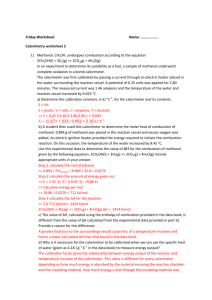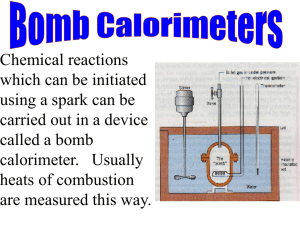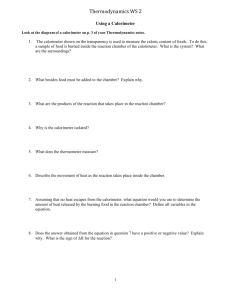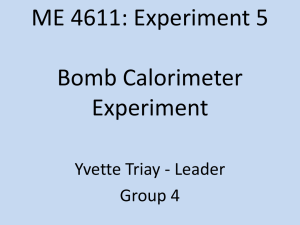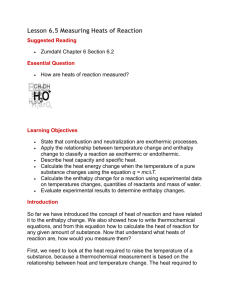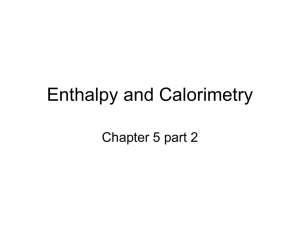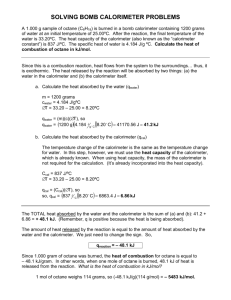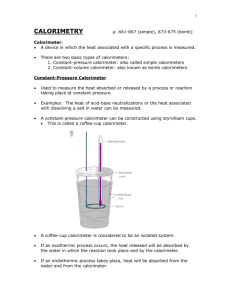Section 5.5 What is the measurement of heat flow? What instrument
advertisement
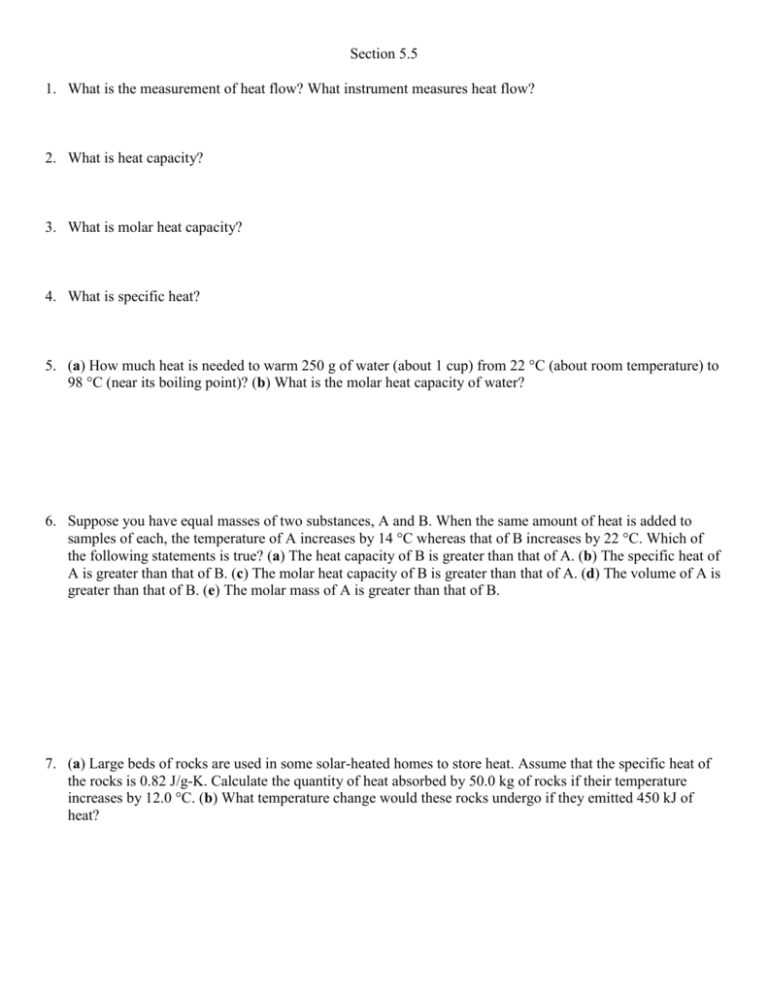
Section 5.5 1. What is the measurement of heat flow? What instrument measures heat flow? 2. What is heat capacity? 3. What is molar heat capacity? 4. What is specific heat? 5. (a) How much heat is needed to warm 250 g of water (about 1 cup) from 22 °C (about room temperature) to 98 °C (near its boiling point)? (b) What is the molar heat capacity of water? 6. Suppose you have equal masses of two substances, A and B. When the same amount of heat is added to samples of each, the temperature of A increases by 14 °C whereas that of B increases by 22 °C. Which of the following statements is true? (a) The heat capacity of B is greater than that of A. (b) The specific heat of A is greater than that of B. (c) The molar heat capacity of B is greater than that of A. (d) The volume of A is greater than that of B. (e) The molar mass of A is greater than that of B. 7. (a) Large beds of rocks are used in some solar-heated homes to store heat. Assume that the specific heat of the rocks is 0.82 J/g-K. Calculate the quantity of heat absorbed by 50.0 kg of rocks if their temperature increases by 12.0 °C. (b) What temperature change would these rocks undergo if they emitted 450 kJ of heat? 8. What is constant pressure calorimetry? 9. When a student mixes 50 mL of 1.0 M HCl and 50 mL of 1.0 M NaOH in a coffee-cup calorimeter, the temperature of the resultant solution increases from 21.0 to 27.5 °C. Calculate the enthalpy change for the reaction in kJ/mol HCl, assuming that the calorimeter loses only a negligible quantity of heat, that the total volume of the solution is 100 mL, that its density is 1.0 g/mL, and that its specific heat is 4.18 J/g-K. 10. When 50.0 mL of 0.100 M AgNO3 and 50.0 mL of 0.100 M HCl are mixed in a constant pressure calorimeter, the temperature of the mixture increases from 22.30 to 23.11 °C. The temperature increase is caused by the following reaction: AgNO3(aq) + HCl(aq) AgCl(s) + HNO3(aq) Calculate ΔH for this reaction in kJ/mol AgNO3, assuming that the combined solution has a mass of 100.0 g and a specific heat of 4.18 J/g-°C. 11. What is bomb calorimetry? 12. The combustion of methylhydrazine CH6N2, a liquid rocket fuel, produces N2(g), CO2(g), and H2O(l): CH6N2(l) + 5 O2(g) 2 N2(g) + 2 CO2(g) + 6 H2O(l) When 4.00 g of methylhydrazine is combusted in a bomb calorimeter, the temperature of the calorimeter increases from 25.00 to 39.50 °C. In a separate experiment the heat capacity of the calorimeter is measured to be 7.794 kJ/°C. Calculate the heat of reaction for the combustion of a mole of CH6N2. 13. The combustion of exactly 1.000 g of benzoic acid in a bomb calorimeter releases 26.38 kJ of heat. If the combustion of 0.550 g of benzoic acid causes the temperature of the calorimeter to increase from 22.01 to 24.27 °C, calculate the heat capacity of the calorimeter. 14. (a) What are the units of molar heat capacity? (b) What are the units of specific heat? (c) If you know the specific heat of copper, what additional information do you need to calculate the heat capacity of a particular piece of copper pipe? 15. (a) What is the specific heat of liquid water? (b) What is the molar heat capacity of liquid water? (c) What is the heat capacity of 185 g of liquid water? (d) How many kJ of heat are needed to raise the temperature of 10.00 kg of liquid water from 24.6 to 46.2 °C? 16. The specific heat of octane, C8H18(l), is 2.22 J/g-K. (a) How many J of heat are needed to raise the temperature of 80.0 g of octane from 10.0 to 25.0 °C? (b) Which will require more heat, increasing the temperature of 1 mol of C8H18(l) by a certain amount or increasing the temperature of 1 mol of H2O(l) by the same amount? 17. When a 6.50-g sample of solid sodium hydroxide dissolves in 100.0 g of water in a coffee-cup calorimeter (Figure 5.17), the temperature rises from 21.6 to 37.8 °C. (a) Calculate the quantity of heat (in kJ) released in the reaction. (b) Using your result from part (a), calculate ΔH (in kJ/mol NaOH) for the solution process. Assume that the specific heat of the solution is the same as that of pure water. 18. A 2.200-g sample of quinone C6H4O2 is burned in a bomb calorimeter whose total heat capacity is 7.854 kJ/°C. The temperature of the calorimeter increases from 23.44 to 30.57 °C. What is the heat of combustion per gram of quinone? Per mole of quinone? 19. Under constant-volume conditions, the heat of combustion of glucose C6H12O6 is 15.57 kJ/g. A 3.500-g sample of glucose is burned in a bomb calorimeter. The temperature of the calorimeter increases from 20.94 to 24.72 °C. (a) What is the total heat capacity of the calorimeter? (b) If the size of the glucose sample had been exactly twice as large, what would the temperature change of the calorimeter have been?
